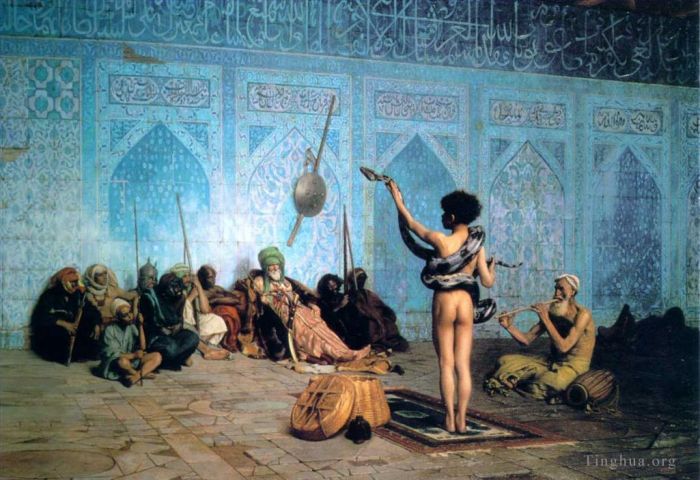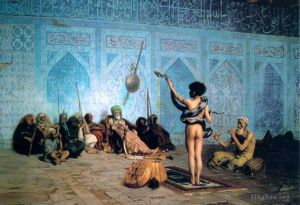SNAKE CHARMER
Jean-Leon Gerome
- Price: Price on Request
- Art Type: Oil Painting
- Size:
- English Comments: 0
- International Comments: 0
- Creating Date:
- Introduction and Works of Jean-Leon Gerome >>
Work Overview
- SNAKE CHARMER
JEAN-LÉON GÉRÔME
c. 1879
Oil on canvas
32 3/8 x 47 5/8 in. (82.2 x 121 cm)
The Snake Charmer is an oil-on-canvas Orientalist painting by French artist Jean-Léon Gérôme produced around 1879.[1] It is signed "J.L Gerome 1880".
The painting depicts a naked boy standing on a small carpet in the centre of a room with blue tiled walls, facing away from the viewer, holding a python which coils around his waist and over his shoulder, while an older man sits to his right playing a fipple flute. The performance is watched by a motley group of armed men from a variety of Islamic tribes, with different clothes and weapons.
The work measures 33 × 48 inches (84 × 122 cm). It is a highly finished academic painting, with a synthesis of Egyptian, Turkish, and Indian elements creating a voyeuristic fantasy for Western audiences. Adult snake charmers didn't perform naked since Islam prohibits that, but children did, in order to create more suspense in the spectator: seeing a poisonous snake held by an unprotected, stark naked boy was more thrilling than seeing it held by a strong, clothed man. Also, child nudity was highly accepted.
Gérôme made the painting on a visit to Constantinople in 1875, and his observations informed details of the painting. The inscriptions on the walls cannot easily be read, but parts are in Arabic Calligraphy. Despite apparent errors in writing, one section in the larger text on top can be identified as a verse from the Koran (2:256) condemning coercion towards Islamic monotheism. The other inscriptions are a dedication to a sultan. The blue tiles are inspired by İznik panels in the Altinyol and Baghdad Kiosk of Topkapi palace.
The painting was used as the front cover of Edward Said's book Orientalism, in which he draws attention to the undercurrent of sensuality dressed up as academic interest. An article by Linda Nochlin, "The Imaginary Orient", in Art in America, (May 1983), pp. 118–131, pp. 187–191, points out that the seemingly photorealistic quality of the painting allows Gérôme to present an unrealistic scene as if it were a true representation of the east. Nochlin considers it better a representation of the West's colonial ideology.
The highly finished style of the painting has also been evaluated within the context of Gerome's resolute opposition to French Impressionism.
A naked boy, accompanied by an elderly musician playing the flute, “charms” a snake. Although Gérôme could have witnessed such a performance during his travels in Egypt, this detailed—almost photographic—image is an invention. A room in Istanbul’s Topkapı Palace inspired the tiled wall, inscribed with Koranic verses, while the stone floor resembles one in a Cairo mosque. The spectators represent a range of ethnicities, wearing a mishmash of clothing and weapons. Paintings of non-Western subjects, often with exotic or erotic undertones, were popular in nineteenth-century Europe and ensured Gérôme’s success.
1880: In his studio in Paris, Jean-Léon Gérôme paints this image of a naked figure, presumably a boy, uncoiling his snake before a small crowd in a palatial setting. Scholars today say he fabricated the scene from multiple sources, including a photograph of tile work in the Topkapi Palace in Istanbul.
Later that year, Adolphe Goupil, his dealer/publisher and also his father-in-law, sells the painting for 75,000 francs to New York collector Albert Spencer.
1888: Spencer sells the work for $19,500 to Alfred Corning Clark, an heir to the Singer sewing machine fortune.
1893: Alfred Corning Clark loans out "The Snake Charmer" so it can be shown at the World's Columbian Exhibition in Chicago.
- Copyright Statement:
All the reproduction of any forms about this work unauthorized by Singing Palette including images, texts and so on will be deemed to be violating the Copyright Laws.
To cite this webpage, please link back here.
- >> English Comments
- >> Chinese Comments
- >> French Comments
- >> German Comments
- >>Report
- Decoration
- La Femme Au Voile
- Bacchante Et LAmour
- Dancing Girl with an Apple
- The Gladiators
- Selene
- Sarah Bernhardt
- Mirmillo
- Sorrow
- Corinth
- Retiarius
- Caesar Crossing the Rubicon
- Corinthe A Seated Female Nude
- Tanagra
- The Ballplayer
- The Harem Bath
- BashiBazouk and his Dog
- Drunken Bacchus and Cupid
- Portrait of a Lady cat167
- The Grief of the Pasha
- A Moorish Bath (Turkish Woman Bathing)
- Woman of Cairo at her Door
- Arnaut blowing Smoke at the Nose of his Dog
- The Call to Prayer
- Head of a Peasant of the Roman Campagna
- Markos Botsaris
- The Death of Caesar
- Dispute DArabes
- Souvenir DAcheres
- Bashi Bazouk singing
- Prayer in the Desert
- Veiled Circassian Lady
- Arab Girl with Waterpipe
- Portrait of a Lady
- Police Verso
- Portrait of a Cactus Collector
- Moorish Bath
- The Cock Fight
- The Negro Master of the Hounds
- Sketch for the Excursion of the Harem
- Napolean and his General Staff in Egypt
- Saber dance engraving
- Tiger on the Watch2
- The age of Augustus the Birth of Christ Greek Arabian
- Portrait of a Lady2
- Excursion of the Harem
- The Carpet Merchant
- Painting Breathes Life into Sculpture
- French 1824to 1904Une Journee Chaud Au Caire Devant2
- Solomons Wall Jerusalem
- Black BashiBazouk
- The Standard Bearer
- Portrait of a Young Boy
- Mufti Reading in His Prayer Stool
- Working in Marble
- A Cafe in Cairo
- Arnaut smoking
- Bathsheba
- The Carpet Merchant Jean Leon Gerome
- Prayer on the Housetops
- Socrates seeking Alcibiades in the House of Aspasia
- Night
- Lion dusk
- The Syrian Shepherd
- Egyptian Recruits crossing the Desert
- The Picador
- Madeleine Juliette Gerome et Ses Poupees
- Lion on rock
- Dante He Hath Seen Well
- Tiger on the Watch 3_2
- Harem Women Feeding Pigeons in a Courtyard
- Anacreon Bacchus and Cupid
- Louis XIV and Moliere
- Cave Canem
- Painting Breathes Life into Sculpture 1893
- Portrait of a Lady3
- Young Greeks at the Mosque
- Lion
- Sculpture Vitam Insufflat Pittura
- Portrait of Mlle Durand
- Cleopatra before Caesar
- Bathers by the Edge of a River
- Pifferari 2
- Diogenes
- Study of a Dog
- Le Jour Du Jugement Dernier
- Treading out the Grain in Egypt
- Quaerens Quem Devoret
- King Candaules
- Self Portrait
- Portrait of a Roman woman
- View of Paestum
- Portrait of Eduoard Delessert
- The Pyrrhic Dance
- The Dance of the Almeh
- The Reception of the Siamese Ambassadors at Fontainebleau
- The Arab and his Steed
- Leaving the Mosque
- The Duel After the Masquerade
- Pygmalion And Galatea
- Waiting for an Audience
- Pifferari cat 196
- Camels at the Fountain
- Napoleon and His General Staff Arabian
- Slave Market
- PersonnageLouis XIII
- Portrait of M Leblond
- The Memnon and Sesostris
- Bisharin Warrior
- Greek Interior sketch
- The Chess Players
- View of Cairo undated
- Arabs crossing the Desert
- A Street Scene in Cairo
- Love the Conqueror
- A Chat by the Fireside
- The Christian Martyrs Last Prayer
- Prayer in the House of an Arnaut Chief
- Pool in a Harem
- The Virgin the Infant Jesus and St John
- Achat DUne Esclave
- Pifferari
- Frederick the Great
- The Duc de La RochefoucauldDoudeauville
- An Arab Caravan outside a Fortified Town Egypt
- The Tulip Folly
- The Plague at Marseilles
- Anacreon 3
- Tiger on the Watch
- Slave Auction
- Interior of a Mosque 1870
- Sais and his Donkey
- Pelt Merchant of Cairo
- Heads of the Rebel Beys
- Egyptian Water Carrier
- BashiBazouk singing
- The Tombe of Hazrat Imam Hisain Allahis Salam
- Un Marchand Darmes Au Caire
- The Last Communion of St Gerome
- Moses on Mount Sinai
- The Muezzins call to prayer
- A Collaboration
- The Colossus of Memnon
- Cairene Horse Dealer
- SNAKE CHARMER
- Femme nue
- The Grey Cardinal
- A Japanese imploring a Divinity
- Harem in the Kiosk
- Prayer in the Mosque
- Pho Xai
- Study Age of Augustus Birth of Christ Greek Arabian
- Arnauts of Cairo at the Gate of BabelNasr Greek Arabian
- The Bacchante
- The Republic
- Summer Afternoon on a Lake
- Phryne before the Areopagus
- Prayer in the Mosque
- Michelangelo
- Whirling Dervishes
- Julius Caesar and Staff
- Recreation in a Russian Camp
- An Arab and his Dog
- View Of Cairo









 Singing Palette
Singing Palette